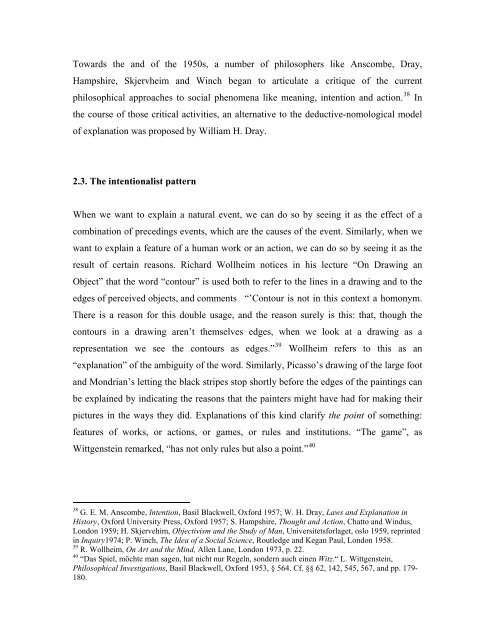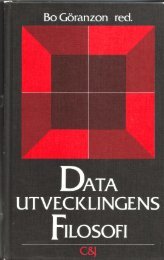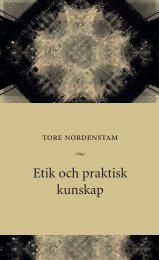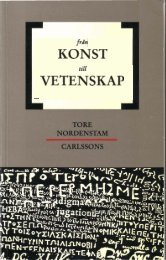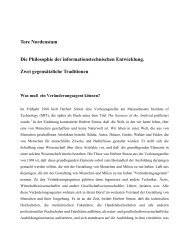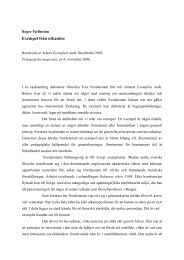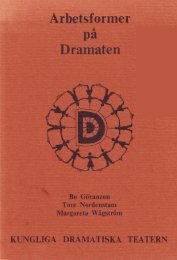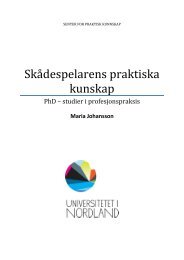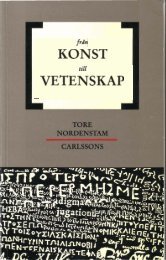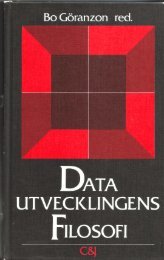tore nordenstam explanation and understanding in the history of art
tore nordenstam explanation and understanding in the history of art
tore nordenstam explanation and understanding in the history of art
Create successful ePaper yourself
Turn your PDF publications into a flip-book with our unique Google optimized e-Paper software.
Towards <strong>the</strong> <strong>and</strong> <strong>of</strong> <strong>the</strong> 1950s, a number <strong>of</strong> philosophers like Anscombe, Dray,<br />
Hampshire, Skjervheim <strong>and</strong> W<strong>in</strong>ch began to <strong>art</strong>iculate a critique <strong>of</strong> <strong>the</strong> current<br />
philosophical approaches to social phenomena like mean<strong>in</strong>g, <strong>in</strong>tention <strong>and</strong> action. 38 In<br />
<strong>the</strong> course <strong>of</strong> those critical activities, an alternative to <strong>the</strong> deductive-nomological model<br />
<strong>of</strong> <strong>explanation</strong> was proposed by William H. Dray.<br />
2.3. The <strong>in</strong>tentionalist pattern<br />
When we want to expla<strong>in</strong> a natural event, we can do so by see<strong>in</strong>g it as <strong>the</strong> effect <strong>of</strong> a<br />
comb<strong>in</strong>ation <strong>of</strong> preced<strong>in</strong>gs events, which are <strong>the</strong> causes <strong>of</strong> <strong>the</strong> event. Similarly, when we<br />
want to expla<strong>in</strong> a feature <strong>of</strong> a human work or an action, we can do so by see<strong>in</strong>g it as <strong>the</strong><br />
result <strong>of</strong> certa<strong>in</strong> reasons. Richard Wollheim notices <strong>in</strong> his lecture “On Draw<strong>in</strong>g an<br />
Object” that <strong>the</strong> word “contour” is used both to refer to <strong>the</strong> l<strong>in</strong>es <strong>in</strong> a draw<strong>in</strong>g <strong>and</strong> to <strong>the</strong><br />
edges <strong>of</strong> perceived objects, <strong>and</strong> comments “’Contour is not <strong>in</strong> this context a homonym.<br />
There is a reason for this double usage, <strong>and</strong> <strong>the</strong> reason surely is this: that, though <strong>the</strong><br />
contours <strong>in</strong> a draw<strong>in</strong>g aren’t <strong>the</strong>mselves edges, when we look at a draw<strong>in</strong>g as a<br />
representation we see <strong>the</strong> contours as edges.” 39 Wollheim refers to this as an<br />
“<strong>explanation</strong>” <strong>of</strong> <strong>the</strong> ambiguity <strong>of</strong> <strong>the</strong> word. Similarly, Picasso’s draw<strong>in</strong>g <strong>of</strong> <strong>the</strong> large foot<br />
<strong>and</strong> Mondrian’s lett<strong>in</strong>g <strong>the</strong> black stripes stop shortly before <strong>the</strong> edges <strong>of</strong> <strong>the</strong> pa<strong>in</strong>t<strong>in</strong>gs can<br />
be expla<strong>in</strong>ed by <strong>in</strong>dicat<strong>in</strong>g <strong>the</strong> reasons that <strong>the</strong> pa<strong>in</strong>ters might have had for mak<strong>in</strong>g <strong>the</strong>ir<br />
pictures <strong>in</strong> <strong>the</strong> ways <strong>the</strong>y did. Explanations <strong>of</strong> this k<strong>in</strong>d clarify <strong>the</strong> po<strong>in</strong>t <strong>of</strong> someth<strong>in</strong>g:<br />
features <strong>of</strong> works, or actions, or games, or rules <strong>and</strong> <strong>in</strong>stitutions. “The game”, as<br />
Wittgenste<strong>in</strong> remarked, “has not only rules but also a po<strong>in</strong>t.” 40<br />
38 G. E. M. Anscombe, Intention, Basil Blackwell, Oxford 1957; W. H. Dray, Laws <strong>and</strong> Explanation <strong>in</strong><br />
History, Oxford University Press, Oxford 1957; S. Hampshire, Thought <strong>and</strong> Action, Chatto <strong>and</strong> W<strong>in</strong>dus,<br />
London 1959; H. Skjervehim, Objectivism <strong>and</strong> <strong>the</strong> Study <strong>of</strong> Man, Universitetsforlaget, oslo 1959, repr<strong>in</strong>ted<br />
<strong>in</strong> Inquiry1974; P. W<strong>in</strong>ch, The Idea <strong>of</strong> a Social Science, Routledge <strong>and</strong> Kegan Paul, London 1958.<br />
39 R. Wollheim, On Art <strong>and</strong> <strong>the</strong> M<strong>in</strong>d, Allen Lane, London 1973, p. 22.<br />
40 “Das Spiel, möchte man sagen, hat nicht nur Regeln, sondern auch e<strong>in</strong>en Witz.“ L. Wittgenste<strong>in</strong>,<br />
Philosophical Investigations, Basil Blackwell, Oxford 1953, § 564. Cf. §§ 62, 142, 545, 567, <strong>and</strong> pp. 179-<br />
180.


